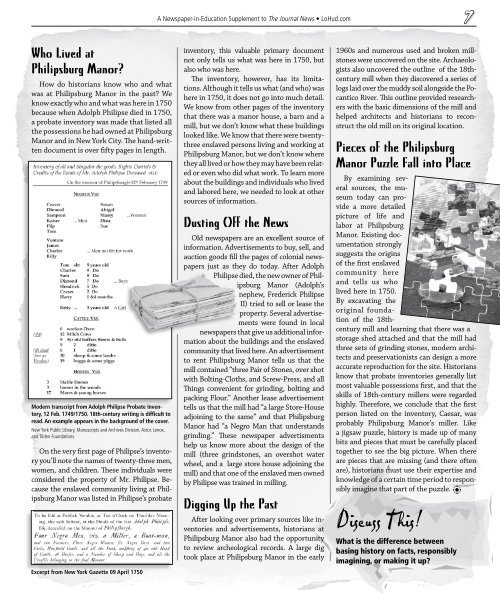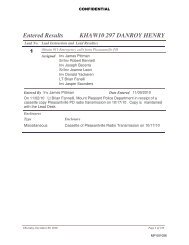Slavery in the Lower Hudson Valley - The Journal News
Slavery in the Lower Hudson Valley - The Journal News
Slavery in the Lower Hudson Valley - The Journal News
Create successful ePaper yourself
Turn your PDF publications into a flip-book with our unique Google optimized e-Paper software.
A <strong>News</strong>paper-<strong>in</strong>-Education Supplement to <strong>The</strong> <strong>Journal</strong> <strong>News</strong> • LoHud.com<br />
<br />
Who Lived at<br />
Philipsburg Manor?<br />
How do historians know who and what<br />
was at Philipsburg Manor <strong>in</strong> <strong>the</strong> past? We<br />
know exactly who and what was here <strong>in</strong> 1750<br />
because when Adolph Philipse died <strong>in</strong> 1750,<br />
a probate <strong>in</strong>ventory was made that listed all<br />
<strong>the</strong> possessions he had owned at Philipsburg<br />
Manor and <strong>in</strong> New York City. <strong>The</strong> hand-written<br />
document is over fifty pages <strong>in</strong> length.<br />
Modern transcript from Adolph Philipse Probate Inventory,<br />
12 Feb. 1749/1750. 18th-century writ<strong>in</strong>g is difficult to<br />
read. An example appears <strong>in</strong> <strong>the</strong> background of <strong>the</strong> cover.<br />
New York Public Library, Manuscripts and Archives Division, Astor, Lenox,<br />
and Tilden Foundations.<br />
On <strong>the</strong> very first page of Philipse’s <strong>in</strong>ventory<br />
you’ll note <strong>the</strong> names of twenty-three men,<br />
women, and children. <strong>The</strong>se <strong>in</strong>dividuals were<br />
considered <strong>the</strong> property of Mr. Philipse. Because<br />
<strong>the</strong> enslaved community liv<strong>in</strong>g at Philipsburg<br />
Manor was listed <strong>in</strong> Philipse’s probate<br />
Excerpt from New York Gazette 09 April 1750<br />
<strong>in</strong>ventory, this valuable primary document<br />
not only tells us what was here <strong>in</strong> 1750, but<br />
also who was here.<br />
<strong>The</strong> <strong>in</strong>ventory, however, has its limitations.<br />
Although it tells us what (and who) was<br />
here <strong>in</strong> 1750, it does not go <strong>in</strong>to much detail.<br />
We know from o<strong>the</strong>r pages of <strong>the</strong> <strong>in</strong>ventory<br />
that <strong>the</strong>re was a manor house, a barn and a<br />
mill, but we don’t know what <strong>the</strong>se build<strong>in</strong>gs<br />
looked like. We know that <strong>the</strong>re were twentythree<br />
enslaved persons liv<strong>in</strong>g and work<strong>in</strong>g at<br />
Philipsburg Manor, but we don’t know where<br />
<strong>the</strong>y all lived or how <strong>the</strong>y may have been related<br />
or even who did what work. To learn more<br />
about <strong>the</strong> build<strong>in</strong>gs and <strong>in</strong>dividuals who lived<br />
and labored here, we needed to look at o<strong>the</strong>r<br />
sources of <strong>in</strong>formation.<br />
Dust<strong>in</strong>g Off <strong>the</strong> <strong>News</strong><br />
Old newspapers are an excellent source of<br />
<strong>in</strong>formation. Advertisements to buy, sell, and<br />
auction goods fill <strong>the</strong> pages of colonial newspapers<br />
just as <strong>the</strong>y do today. After Adolph<br />
Philipse died, <strong>the</strong> new owner of Philipsburg<br />
Manor (Adolph’s<br />
nephew, Frederick Philipse<br />
II) tried to sell or lease <strong>the</strong><br />
property. Several advertisements<br />
were found <strong>in</strong> local<br />
newspapers that give us additional <strong>in</strong>formation<br />
about <strong>the</strong> build<strong>in</strong>gs and <strong>the</strong> enslaved<br />
community that lived here. An advertisement<br />
to rent Philipsburg Manor tells us that <strong>the</strong><br />
mill conta<strong>in</strong>ed “three Pair of Stones, over shot<br />
with Bolt<strong>in</strong>g-Cloths, and Screw-Press, and all<br />
Th<strong>in</strong>gs convenient for gr<strong>in</strong>d<strong>in</strong>g, bolt<strong>in</strong>g and<br />
pack<strong>in</strong>g Flour.” Ano<strong>the</strong>r lease advertisement<br />
tells us that <strong>the</strong> mill had “a large Store-House<br />
adjo<strong>in</strong><strong>in</strong>g to <strong>the</strong> same” and that Philipsburg<br />
Manor had “a Negro Man that understands<br />
gr<strong>in</strong>d<strong>in</strong>g.” <strong>The</strong>se newspaper advertisments<br />
help us know more about <strong>the</strong> design of <strong>the</strong><br />
mill (three gr<strong>in</strong>dstones, an overshot water<br />
wheel, and a large store house adjo<strong>in</strong><strong>in</strong>g <strong>the</strong><br />
mill) and that one of <strong>the</strong> enslaved men owned<br />
by Philipse was tra<strong>in</strong>ed <strong>in</strong> mill<strong>in</strong>g.<br />
Digg<strong>in</strong>g Up <strong>the</strong> Past<br />
After look<strong>in</strong>g over primary sources like <strong>in</strong>ventories<br />
and advertisements, historians at<br />
Philipsburg Manor also had <strong>the</strong> opportunity<br />
to review archeological records. A large dig<br />
took place at Philipsburg Manor <strong>in</strong> <strong>the</strong> early<br />
1960s and numerous used and broken millstones<br />
were uncovered on <strong>the</strong> site. Archaeologists<br />
also uncovered <strong>the</strong> outl<strong>in</strong>e of <strong>the</strong> 18thcentury<br />
mill when <strong>the</strong>y discovered a series of<br />
logs laid over <strong>the</strong> muddy soil alongside <strong>the</strong> Pocantico<br />
River. This outl<strong>in</strong>e provided researchers<br />
with <strong>the</strong> basic dimensions of <strong>the</strong> mill and<br />
helped architects and historians to reconstruct<br />
<strong>the</strong> old mill on its orig<strong>in</strong>al location.<br />
Pieces of <strong>the</strong> Philipsburg<br />
Manor Puzzle Fall <strong>in</strong>to Place<br />
By exam<strong>in</strong><strong>in</strong>g several<br />
sources, <strong>the</strong> museum<br />
today can provide<br />
a more detailed<br />
picture of life and<br />
labor at Philipsburg<br />
Manor. Exist<strong>in</strong>g documentation<br />
strongly<br />
suggests <strong>the</strong> orig<strong>in</strong>s<br />
of <strong>the</strong> first enslaved<br />
community here<br />
and tells us who<br />
lived here <strong>in</strong> 1750.<br />
By excavat<strong>in</strong>g <strong>the</strong><br />
orig<strong>in</strong>al foundation<br />
of <strong>the</strong> 18thcentury<br />
mill and learn<strong>in</strong>g that <strong>the</strong>re was a<br />
storage shed attached and that <strong>the</strong> mill had<br />
three sets of gr<strong>in</strong>d<strong>in</strong>g stones, modern architects<br />
and preservationists can design a more<br />
accurate reproduction for <strong>the</strong> site. Historians<br />
know that probate <strong>in</strong>ventories generally list<br />
most valuable possessions first, and that <strong>the</strong><br />
skills of 18th-century millers were regarded<br />
highly. <strong>The</strong>refore, we conclude that <strong>the</strong> first<br />
person listed on <strong>the</strong> <strong>in</strong>ventory, Caesar, was<br />
probably Philipsburg Manor’s miller. Like<br />
a jigsaw puzzle, history is made up of many<br />
bits and pieces that must be carefully placed<br />
toge<strong>the</strong>r to see <strong>the</strong> big picture. When <strong>the</strong>re<br />
are pieces that are miss<strong>in</strong>g (and <strong>the</strong>re often<br />
are), historians must use <strong>the</strong>ir expertise and<br />
knowledge of a certa<strong>in</strong> time period to responsibly<br />
imag<strong>in</strong>e that part of <strong>the</strong> puzzle. b<br />
Discuss This!<br />
What is <strong>the</strong> difference between<br />
bas<strong>in</strong>g history on facts, responsibly<br />
imag<strong>in</strong><strong>in</strong>g, or mak<strong>in</strong>g it up?






